In this Good Practice Note, Dr Devesh Thakur and Mr Amit Upmanyu share their experience on setting up community fodder interventions in Himachal Pradesh through community mobilization, and by forging partnerships among varied stakeholders. The note also showcases the model approach for setting up low-cost community fodder banks through a convergence mode.
CONTEXT
Adequate availability of feed and fodder is critical for sustainable growth and development of the livestock sector. India faces a net deficit of 63% in green fodder, 24% in dry crop residues, and 64% in feeds. Projections show a further increase in demand by 2025 due to changing feeding patterns and more dietary reliance on livestock and its products (Kumar et al. 2012). Poor feeding resources have resulted in sub-optimal performance of livestock production in India as animals suffer from poor health and productivity. The deficit also causes an exorbitant increase in prices of feed and crop residues in many parts of the country (Owen et al. 2012).
Green fodder cultivation provides nutritious feed and helps to cut down the feeding cost which forms 65-70% of the cost of livestock rearing (GOI 2012). Unfortunately, the area cultivated for fodder cannot be increased due to more competition between various land uses for cultivable land (Kumar et. al. 2012). Fodder scarcity also has significantly contributed to greater drudgery for women in farming (Box 1). Community Fodder Banks are a good alternate strategy to augment fodder production. In such fodder banks, a group of farmers come together to raise multiple fodder crops consisting of trees, grasses and legumes largely in wastelands/non-arable lands (Venugoplan et al. 2012). Unfortunately, the popularization of such extension initiatives have remained woefully weak across the country and very few initiatives have been undertaken in this regard.
In this Good Practice Note, we explain the initiatives of community fodder interventions undertaken by the Department of Veterinary & Animal Husbandry Extension Education, Dr GC Negi College of Veterinary and Animal Sciences (DGCNCOVAS), Palampur, Chaudhary Sarwan Kumar Himachal Pradesh Krishi Vishvavidyalaya (CSK HPKV), and Himmotthan Society (an Initiative of Tata Trusts) through the support of National Bank on Agriculture and Rural Development (NABARD), Shimla, Himachal Pradesh, India.
THE INITIATIVE
During the last two years (2018–2020) the two institutions – DGCNCOVAS, CSKHPKV and Himmotthan – had collaborated with each other in implementing field activities. Scientists of CSKHPKV had organised trainings for farmers and animal health camps in collaboration with Himmotthan in their intervention villages. Himmotthan had hosted the trainees and students from CSKHPKV for field exposures. To take the common mandate of livestock development forward, a project on ‘Community Fodder Interventions for Dairy Development’ was conceptualized and designed by DGCNCOVAS scientists of CSKHPKV Palampur and Himmotthan. This project was sanctioned by NABARD for a modest amount of Rs 24.73 lakhs for three years and it had the objective of community fodder interventions in Kangra district, Himachal Pradesh. The project involved community participation and training in fodder production and animal health. The initiative combined the scientific expertise of the college and the university with the community mobilization experience and Himmotthan’s presence among farming communities by entering into a formal partnership among these actors so as to implement community fodder interventions in the region.
GOOD PRACTICES
1. Selection of Villages
The project is being implemented in two blocks of Baijnath and Rait of Kangra district in Himachal Pradesh. In these two blocks, Gram Panchayats of Ghorpith, Kandral, Beth Jhikli, Madhonagar in Baijnath block and Gram Panchayats of Bhaled, Kanol, Drini and Rirkamar of Rait block have been selected. These areas have been selected as every household in the village owns dairy animals. Women in the region form the major workforce in dairy farming as men opt for non-farm jobs. Himmotthan has been working in these two locations for two years and have organised around 80 SHGs in the villages which are trained on institutional aspects, accounts and book keeping. They follow practices such as monthly meeting, monthly saving, accounting and book keeping and linking with bank. Under the project SHGs are trained and facilitated by project staff of the Department of Veterinary & Animal Husbandry extension education and Himmothan Society on fodder promotion and overall livestock management practices.
2. Group Meetings
In the meetings facilitated by project staff of the Department of Veterinary & AH Extension Education and Himmothan Society, SHG members are instructed on the activities to be undertaken in the project and the process of fodder plantations. Besides, meetings with local Gram Panchayat representatives are conducted to explain the concept and sensitise them towards mobilisation of resources on the proposed fodder plantations. SHG members and local farmers present it in the Gram Sabha meetings and a resolution is passed at Gram Sabha for allocation of site and funds under MGNREGA for the activity.
3. Selection of Site
The open lands around farmers’ homesteads such as wastelands/common property resources (CPRs)/uncultivated lands are selected. Selection is done by conducting group meetings with SHG members and local Gram Panchayats. This is followed by site visits of the project staff, officials from Himmothan Society, and local representatives. Once the site is finalised, the resolution to utilise funds under MNREGA is passed by Gram Panchayats. The SHG beneficiaries also contribute their minimal share for site development in the form of voluntary labour and fencing poles.
 Selection of site
Selection of site
| Box 1: Fodder, Women’s Drudgery and Community Fodder Banks The association between women and fodder has been phenomenal in developing countries of the world (World Bank 1989). Rural women are food providers not only to family members but also to animal stock. An average of 1.38 weekly hours are spent by women in fodder collection, 1.64 hours in fetching water, and 1.59 weekly hours at collecting fuel wood. These activities are vital for family livelihood. Participation of women in these activities can be six times more than that of men. (Hirway & Jose 2011). However, these activities are time-consuming, particularly with the increasing depletion and degradation of common property resources in India (Planning Commission 2007). In spite of this, the role of women has remained unrecognized and undervalued in the forage value chains (Partap 2011).Carrying heavy backloads of fodder from a long-distance affect women’s health, cause stress on back, calf muscles, even cause accidents, and result in malnutrition of children (Dhyani et al. 2013, Kishtwaria & Rana 2007). This fodder-based drudgery can be reduced through fodder banks. The fodder banks also reduce anthropogenic pressure on the forests of Western Himalaya (Shalini & Maikhuri 2012). Introduction of superior fodder varieties along with chaff cutting is a simpler women centric technological intervention to reduce drudgery in rural dairy farming (Ponnusamy 2020). A community fodder bank is nothing but a group of farmers coming together to raise multiple fodder crops including trees, grasses and legumes, largely in non-arable or wastelands in order to meet the fodder requirement especially during lean periods. These banks not only increase fodder availability but also reduce soil erosion, and replenishes soil fertility as it rebuilds the nitrogen content of the soil (Venugopalan et al. 2016). |
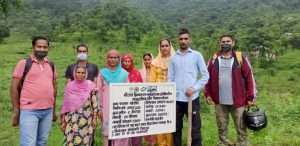 Beneficiaries with Community Fodder Bank
Beneficiaries with Community Fodder Bank
4. Land Preparation
Since most of the land selected is either wastelands infested with weeds or rough terrain, cleaning of the area is the first step. After cleaning the area, pre-plantation work is carried out on the plot which includes staggered contour trenches for water conservation and grass plantation, pit digging for plants and fencing, gully plugs, recharge pits and compost pits. These measures reduce erosion of top soil, increase the moisture regime of the plots by increasing water infiltration and thus increase soil fertility.
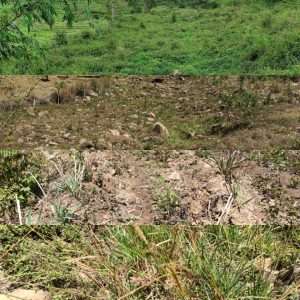 From a weed infested area to a community fodder bank
From a weed infested area to a community fodder bank
5. Fencing
Once the pre-plantation activities are complete the entire plot is fenced using poles and barbed wires. Since most of these plots are common land and waste lands, it is extremely important to protect the area from cattle grazing, theft or any other damage.
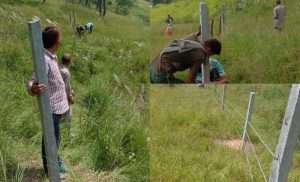 Fencing in Operation
Fencing in Operation
6. Plantation
Plantation work was carried out in the rainy season (July-August) as climatic conditions are better suited for adaptation and growth. The following varieties of fodder grasses were planted:
- Napier Bajra Hybrid;
- Setaria;
- Paspalum notatum;
- Bracharia brizantha.
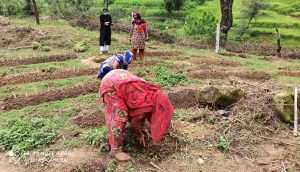 Planting of Fodder Roots
Planting of Fodder Roots
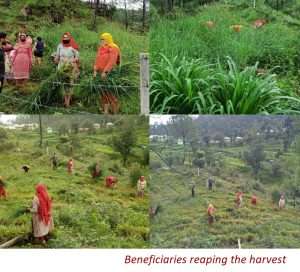 Out of these, the first two fodder species grew well in the interventions made (Box 2). Besides these, common fodder/medicinal tree plants such as Mulberry (Morus alba), Indian gooseberry (Phyllanthus emblica), Jaman (Syzygium cumini), Kachnar (Bauhinia variegate), and Oak (Quercus) have also been planted. Based on the number of trenches created in the plot, 10-12 quintals of fodder roots were planted in each community fodder bank. A total of 40-45 quintals of fodder roots were planted. The labour work for plantation and pre-plantation activities was done under MGNREGA.
Out of these, the first two fodder species grew well in the interventions made (Box 2). Besides these, common fodder/medicinal tree plants such as Mulberry (Morus alba), Indian gooseberry (Phyllanthus emblica), Jaman (Syzygium cumini), Kachnar (Bauhinia variegate), and Oak (Quercus) have also been planted. Based on the number of trenches created in the plot, 10-12 quintals of fodder roots were planted in each community fodder bank. A total of 40-45 quintals of fodder roots were planted. The labour work for plantation and pre-plantation activities was done under MGNREGA.
| Box 2: Brief Description of Grasses established in the Community Fodder Bank
1. Setaria : This grass can survive in the long, hot and dry seasons and grows well at 20-25 degree Celsius, and is more cold tolerant than most tropical and sub-tropical grasses. This perennial fodder can be successfully grown in irrigated and rainfed situations. It can even withstand frost conditions. 2. Napier Bajra Hybrid (NB hybrid): This is an inter-specific hybrid between Napier grass (Pennisetum purpureum) and Bajra (Pennisetum typhoides). It is widely known as Bajra-Napier Hybrid or Elephant grass. Hybrid Napier is a perennial grass which can be retained in the field for 2-3 years. Compared to Napier grass, Hybrid Napier produces larger and softer leaves. It possesses more tillers and leaves than Napier and is more vigorous and higher in fodder yield and quality. It contains 9-12% crude protein and 30.5% crude fibre. One rooted slip or stem cutting is planted at a depth of 3-5 cm on one side of the ridge at 75 × 30 cm spacing at the rate of 40,000 rooted slips or stem cuttings/ha in the period of mid-February to July. The hybrid once planted supplies fodder continuously and regularly for a period of three years The average green fodder yield of 150-200 tonnes/hectare per year can be undertaken under irrigated conditions. |
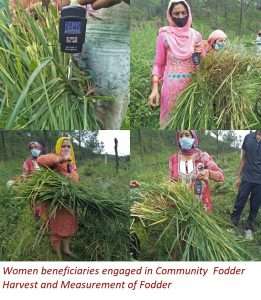 7. Protection and Management
7. Protection and Management
Protection and management of fodder plots is very crucial for the success of this entire intervention. Since each plot is assigned to one or more SHG groups, they are responsible for the protection of the plot from cattle grazing, damage of plants and fence, and theft of grass. The area of each plot is subdivided equally among the group members for ease of management and protection. Each group’s members are responsible for weeding, intercultural operations and manuring of their portion of the plot. During the harvest every member will get the grass from their part of the plot.
8. Harvest of Fodder
The SHG members have harvested improved fodder crops two times up until July 31, 2021, from the plot established during July-August 2020. The detailed fodder production in one year appears sufficient as the area had negligible fodder production before intervention. The estimated fodder production from one community fodder bank in Ghorpith village is presented in Table 1.
| Table 1. Community Fodder Bank at Village Ghorpith (Baijnath Block) | |
| 1. Land | 2 hectares |
| 2.Trenches made | 687 |
| 3. Average yield of superior fodder from one trench | 5.05 kg |
| 4. Average trench size | 14.24 |
| 5. Total yield from all trenches of total area (5880 square feet) | 3469.35 kg |
| 6. Total times harvested | Twice (June & July) |
| 7. Total fodder yield from superior fodder variety | 69.38 Quintals |
| 8. Average grass yield from 14 square feet | 1.01 Kilogram |
| 9. Total yield from normal grass from remaining area (2 Hectares-5880 sq. feet) | 10757.92 |
| 10. Total green fodder production in a year | 107.58 (Local Grass) + 69.38 (Improved Grass=176.96 Quintals |
| 11. Tree species planted | Mulberry (Morus alba),
Indian gooseberry (Phyllanthus emblica), Jaman (Syzygium cumini), Orchid Tree (Bauhinia variegate), and Oak (Quercus) |
| * Fodder production is expected to increase further as grasses establish themselves properly. | |
9. Establishing Village Fodder Nurseries and Promotion of Fodder Cultivation
To create local availability of superior fodder grass of Napier Bajra, Setaria and common fodder trees such as Morus, village fodder nurseries have also been set up. Two farmers have come forward to set up such nurseries though widespread promotion of nurseries has remained challenging due to the small landholding size of farmers.
10. Small Group Trainings
Besides establishing community fodder banks, small group trainings have been regularly conducted on identified priority areas. These training programmes and demonstrations have helped farmers to gain knowledge on scientific feeding of livestock. In one year 20 small group trainings have been conducted in the vicinity of households of farmwomen. Most of these trainings involve method demonstrations on feed formulation, proven Ayurvedic formulations against common livestock problems such as ecto-parasitic infestation, endoparasites, papillomatosis, mastitis, etc.
Table 2. Details of small group Training Demonstrations conducted for dairy farmers
| No. | Title of Training/Demonstrations | No. of Farmers Benefitted till date |
| 1. | Improved fodder production & mineral mixture feeding | 83 |
| 2. | Demonstration on Ecto-Parasitic management: Prevention & control through herbal methods | 47 |
| 3. | Demonstration on feed preparation through locally available ingredients | 97 |
| 4. | Management of Mastitis in cattle along with herbal methods to control through demonstration | 57 |
| 5. | Management of Warts & Bloat along with herbal methods to control | 47 |
| 6. | Centralized training-cum-animal health extension camp | 244 |
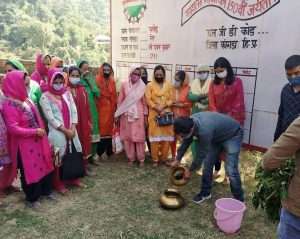 Training Demonstration on Herbal Methods to control common livestock ailments
Training Demonstration on Herbal Methods to control common livestock ailments
11. Popularisation of Fodder Production
Along with promoting perennial fodder varieties on common land, cultivation improved fodder grasses such as oats and Chari and Bajra which were also taken up on private land. A total of 472 families have adopted the cultivation of improved fodder seeds of oats and Chari and Bajra this year. The improved fodder seeds have been provided on user charge basis which is suggestive of high demand for such seeds in the region.
LESSONS
Timeline for setting up a community fodder ban
Table 3. Timeline for setting up a CFB
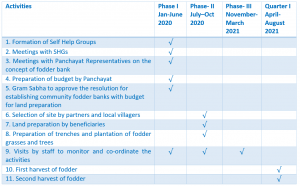
Cost of a community fodder bank under the convergence approach
Table 4 depicts the average cost for setting up of fodder banks under the current interventions. Under the convergence approach out of a total of Rs. 1,18,700, the maximum amount has been utilised through MNREGA (Rs 59,420) which ultimately profited the beneficiary families of the village in the form of wage employment. The money from NABARD and Himmothan was utilised for fencing of the area with contribution from SHG member beneficiaries. The cost of fodder roots was not included as roots were readily available with IGFRI Palampur, and CSKHPKV Palampur, under their technology transfer programme. Therefore, at a meagre cost of Rs 1,19,000 (approx.), one fodder bank was established in each of the four village Panchayats.
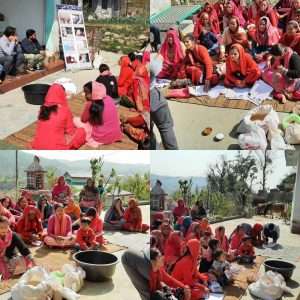 Demonstration on Feed preparation through locally available ingredients
Demonstration on Feed preparation through locally available ingredients
Table 4. Average cost/group for Setting Up Community Fodder Bank: Case Study of Fodder Bank set up at Village Panchayat Kandral, Baijnath block
| Name of Village Panchayat | Kandral |
| i. Total land | 1.5 hectares |
| ii. Previous use | Infested with Lantana |
| iii. Beneficiary SHG members | 14 |
| iv. Contribution by beneficiaries (INR) | 10,160 |
| v. MNREGA resources (INR) | 59,420 |
| vi. NABARD contribution (INR) | 25,000 |
| vii. Himmotthan contribution (INR) | 24,120 |
| viii. Grasses from CSKHPV Palampur & IGFRI, Palampur | 10 quintals |
| ix. Total (INR) | 1,18,700 |
| x. Total Fodder Yield till date | 173 Quintals |
Partnerships and Convergence
One of the main reason for our success has been the partnership that we developed among the following actors.
- Himmotthan Society:
Himmotthan Society, an associate organization of the Tata Trusts, has been working with mountain communities in the central and western Himalayan regions of India since 2007. Himmotthan is working on agriculture, livestock, livelihood, skills, education, renewable energy, water and sanitation. Presently Himmotthan is reaching out to more than 98,622 HHs, 1846 villages, of Uttarakhand, Himachal Pradesh and Ladakh. Himmotthan started its work in Kangra district of Himachal Pradesh in 2018 on community institution development, livestock value chain development and agriculture. Since then, Himmotthan has promoted fodder nurseries, fodder plantations on common and private land, and forage crops on private lands in two clusters (Rait and Baijnath) of Kangra district. It also focused on developing women’s institutions (SHGs) in the villages and promoting better cattle management practices among farmers through trainings and awareness generation. The organisation, therefore, has experience of working with local community. - Dr GC Negi College of Veterinary and Animal Sciences, CSKHPKV Palampur:
The CSK Himachal Pradesh Agricultural University is engaged in planning, implementation, monitoring and evaluation of technological solutions for livestock production through Dr GC Negi College of Veterinary and Animal Sciences, Palampur. It ensures all technical support in fodder development, animal health and production through services of technical manpower. It provides financial support and technical manpower as per the terms and conditions of the project and the university norms through Project Staff and Associated Scientists (PI and CO-PIs) of CSKHPKV Palampur.
- NABARD (National Bank on Agriculture and Rural Development): It sanctioned a project on community fodder interventions for dairy development in the district worth Rs 24.73 lakhs and the amount is being spent on establishing community fodder banks, individual fodder nurseries, trainings on dairy farming, SHG meetings, salaries, etc.
Gram Panchayats of Cluster Villages: Gram Panchayats of cluster villages ensured necessary support in selection of site, availability of funds through MNREGA, and social stamping of the work being undertaken in the cluster villages.
IMPACT
Setting up of Community Fodder Banks
Till date, four Community fodder banks have been established on community wastelands, common lands in one year. These banks have been set up with average area of 1.5 hectares and thus six hectares of area have been brought under community fodder production.
Increased production of fodder
The estimated fodder production has been 738.9 quintals. Out of this 193.54 has been of superior fodder varieties of Setaria, Napier Bajra and Super Napier. Of the remaining, 545.36 quintals have been the local grass variety. Production is expected to increase in coming years.
Gender focus
The participation of communities involving women SHGs and farmers during each stage of the project has given them an insight into techniques of wasteland management, fodder production and preservation along with scientific animal feeding.
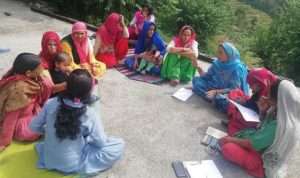 Women SHG Meetings
Women SHG Meetings
CHALLENGES FACED
Aftercare practices in community fodder banks
The main reported challenge has been in encouraging the beneficiaries to adopt aftercare practices such as weed management, fertilisation/manuring of the community fodder banks. In one of the fodder banks weed growth had been observed which required aftercare. Though the farmers were made aware, yet, aftercare has remained a challenge. One of the proposed solutions has been to demarcate the sub areas for each member for aftercare. In one village area the work on land plantation had to be abandoned due to local level politics.
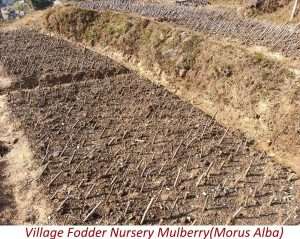 Non availability of fodder trees
Non availability of fodder trees
Non-availability of sufficient fodder trees has remained a severe constraint as there is lack of fodder nurseries in the area. Department of Forests, Govt. of HP is the sole provider and its priority has been to meet its own targets. Secondly, very few fodder species, like Orchid Tree (Bauhinia Variegate) are available, but important fodder species such as Bhimal (Grewia optiva), Bamboo (Dendrocalamus strictus), and White Locust Tree (Robinea pseudoacacia) are not easily available. As a solution the project has established two nurseries of fodder grasses and trees which will provide planting material in the next year.
END NOTE
Community participation has been reasonably good in the community fodder initiatives and capacity building programmes. Women folk from nearby villages have also been participating in the meetings and training programmes. In some instances neighbouring Gram Panchayats are willing to establish such fodder banks through support of COVAS CSKHPKV Palampur and Himmothan Society. There is a plan to extend the fodder bank activities in the next two years and more farm women of neighbouring villages will benefit.
REFERENCES
Dhyani S, Maikhuri RK and Dhyani D. 2013. Utility of fodder banks for reducing women drudgery and anthropogenic pressure from forests of Western Himalaya. National Academy Science Letters 36(4):453-460.
GOI. 2012. Report of the Working Group on Animal Husbandry and Dairying. Twelfth Five-Year Plan, 2012- 2017. New Delhi: Planning Commission.
Hirway I and Jose S. 2011. Understanding women’s work using time-use statistics: The case of India. Feminist Economics 17(4):67-92. DOI: 10.1080/13545701.2011.622289
Kishtwaria J and Rana A. 2007. Ergonomic interventions in fodder collection-impact on rural farm women. The Anthropologist 9(3):221-224. DOI: 10.1080/09720073.2007.11891003
Kumar S, Agrawal RK, Dixit AK, Rai AK, Singh JB and Rai SK. 2012. Forage production technology for arable lands. Technology Bulletin, 39(9):255-260. Jhansi: IGFRI.
Owen E, Smith T and Makkar H. 2012. Successes and failures with animal nutrition practices and technologies in developing countries: A synthesis of an FAO e-conference. Animal Feed Science and Technology 174(3-4):211-226.
Partap T. 2011. Hill agriculture: Challenges and opportunities. Indian Journal of Agricultural Economics 66(902-2016-67891).
Planning Commission of India. 2007. Report of the Working Group on Environment and Forest, for the Eleventh Five-Year Plan. New Delhi: Government of India.
Ponnusamy K, Oberoi PS and Kumar A. 2020. Impact analysis of women centric technological interventions in rural dairy farming. Indian Journal of Dairy Science 73(4).
Shalini D and Maikhuri RK. 2012. Fodder banks can reduce women drudgery and anthropogenic pressure from forests of Western Himalaya. Current Science 103(7).
Tewari P, Mittra B and Phartiyal P. 2008. Perennial fodder grasses: Key for management of community forests in Indian Himalaya. IASC 12th Biennial International Conference Governing Shared Resources: Connecting Local Experience to Global Challenges. Cheltenham, United Kingdom.
Venugopalan VK, Prabhakar M, Gopinath KA, Pankaj PK and Rao CS. 2016. Community Fodder Banks for addressing forage shortage in rainfed areas. Indian Farming 66(2).
World Bank. 1989. Women in Pakistan: An economic and social strategy. Washington, DC: The World Bank.
ACKNOWLEDGEMENTS
The authors would like to acknowledge the financial support extended by the National Bank of Agricultural and Rural Development, (NABARD), Shimla, HP, India.
 Dr Devesh Thakur works as Assistant Professor in the Department of Veterinary and AH Extension Education DGCN College of Veterinary and Animal Sciences, CSK Himachal Pradesh Agricultural University, Palampur, Himachal Pradesh. Email: drdth4@gmail.com
Dr Devesh Thakur works as Assistant Professor in the Department of Veterinary and AH Extension Education DGCN College of Veterinary and Animal Sciences, CSK Himachal Pradesh Agricultural University, Palampur, Himachal Pradesh. Email: drdth4@gmail.com
 Mr Amit Upmanyu, Senior Project Officer, Himmotthan Society (Associate Organization of Tata Trusts), Palampur, Himachal Pradesh. Email: upmanyu.amit@gmail.com
Mr Amit Upmanyu, Senior Project Officer, Himmotthan Society (Associate Organization of Tata Trusts), Palampur, Himachal Pradesh. Email: upmanyu.amit@gmail.com

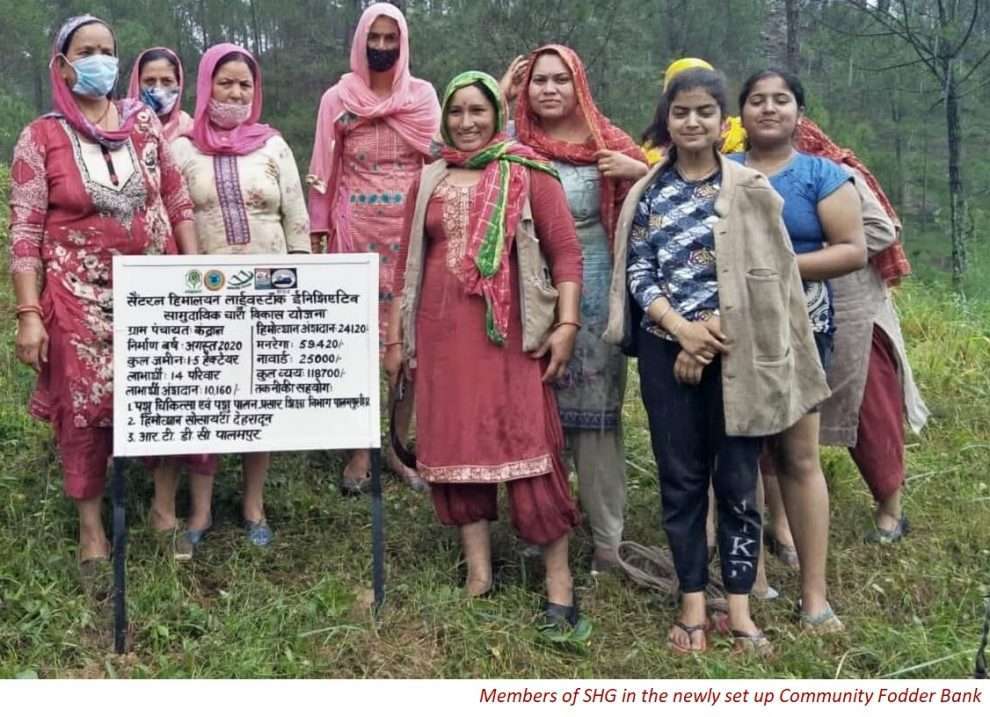

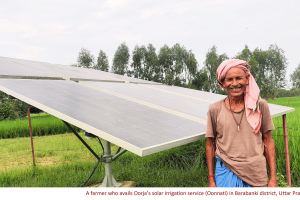
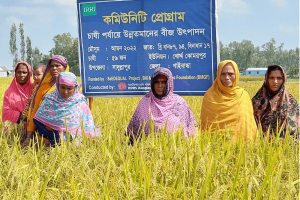
Add Comment